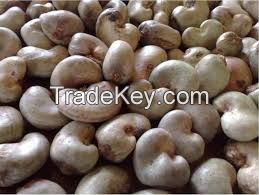Description
The true fruit of the cashew tree is a kidney or boxing-glove
shaped drupe that grows at the end of the cashew apple. The drupe
develops first on the tree, and then the pedicel expands to become
the cashew apple. Within the true fruit is a single seed, which is
often considered a nut, in the culinary sense
Cashew tree bears many, edible, pear-shaped false fruits or
accessory fruits\' called "cashew apples." Cashew nut which is a
true-fruit, firmly attaching to the bottom end of cashew-apple,
appearing like a clapper in the bell. Botanically, this tiny, bean
shaped, gray true fruit is a drupe, featuring hard outer shell
enclosing a single edible kernel known commercially as cashew
nut.
Structurally, this Cashew "drupe" is made up of outer, hard shell
and inner, edible kernel. Cashew shell composes of a toxic phenolic
resin, urushiol; a potent caustic skin irritant toxin and therefore
should be eliminated. In the processing units, the whole cashew is
treated under the high flame to destroy urushiol resin. Thus
roasted cashew becomes safe to handle with bare hands by workers,
who then mechanically shell the nuts to extract underlying edible
cashew kernel.
Cashew nut measures about an inch in length, 1/2 inches in
diameter, and kidney or bean shape, with a smooth surface and
smooth curvy pointed tip. Each nut splits into two halves as in
legumes. The cream white kernel features firm yet crunchy texture
and sweet, buttery flavor.
